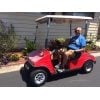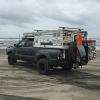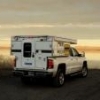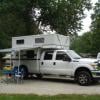Disclaimer: This article is aimed at prospective or new buyers of the regular Four Wheel Campers or campers that come with compressor 2-way refrigerators. I am not a technician or engineer. Following information is based on 2 years of research and personal experience.
Overview
There still seems to be a lot of confusion for the average compressor refrigerator owner as to whether they need one battery or two, roof solar panels or portables.
My advice if you purchase the camper with the Dometic compressor refrigerator: buy the Aux battery system with TWO batteries…And TWO solar panels - two 100 watt solar panels on the roof or one panel on roof and one 60-100 watt portable - Regular heavy (24 pound panels) or the lightweight ( 4 pound) bendable 100 watt panels from Renology or Global Solar.
Third party panels:
Solarblvd.com has good prices on regular (heavy) panels .
Lightweight bendable panels
Renology http://www.renogy-st...tHXAaAkmS8P8HAQ
Global Solar http://www.globalsol...ible-modules/rv
Reason why…..
Dometic compressors refrigerators –
Dometic/Waeco website specs list amp draw for the 65 liter at 3.5 amps.
Brenda at Four Wheel Campers quotes 4.8 amps average.
I know manufacture specs were produced in a lab environment under ideal conditions. Field conditions are different. For this article I am rounding off to an average of 5 amps (model 65L) per hour depending on ambient temperature and number of times door is opened .
At a 5 amp draw one battery will run the fridge maximum of 8 hours. Adding the furnace blower, fan, lights (couple hours at night) pushes average up to 6 - 7 amps per hour which DECREASES ONE battery running time to 5 - 7 hours per night. Average Night time darkness 11.5 -14 hours.
Solar panel output:
A 100 watt panel outputs 5.8 amps max in June -August ( sun high in sky- 11am-2pm). In October - March output drops to around 60% - about 3.5 amps (sun low in the sky) because roof panels can't be tilted towards the sun.
One solar panel in winter will output approx 3-4 amps an hour NOT enough to run the Dometic and charge the battery.
Reason to add one roof solar panel at time of order:
When Dometic is running and engine is off while out sightseeing, battery is being drained. Restarting and driving for less than 4 hours doesn't top off the battery. Owner will need to add one 100 watt panel on the roof to just run the fridge during the day (two panels to also charge the battery).
For new owners unfamiliar with the process
Dometic 65L compressor refrigerators –
draw about 5 amps per hour. One 80 amp hour battery with 40 usable amp hours will run the fridge ONLY for 8 hours (40 divided by 5 = 8 hours) Reason: 12 volt devices stop working when voltage drops below 12 volts - about 50% of the battery volume.
You will experience at least 11 hours of night darkness (unless you’re in Seattle or Alaska) so one battery is NOT enough capacity to last the night.
One battery example:
Sun sets at 7:30 pm… Fridge cycling on and off…At 3:30 am (8 hours later) fridge shuts off because the voltage is less than 12 volts. Sun rises at 7 am. 4.5 hours passes until sunrise solar begins charging battery back to 12 + volts. After 2-4 more hours with all electrical devices off voltage has risen enough to turn fridge back on.. Fridge has been off 6 or more hours before cool down starts. How warm is the inside of fridge at start of cycle? What is the condition of your food?
And you won’t be drawing just 5 amps an hour because of the other devices you use. I figure average draw 6-7 amps per hour.
Except for the Dometic compressor fridge and heater and maybe the Fantastic Fan (in summer), the rest of the devices will run for a portion of an hour a portion of the day. For instance unless you’re using the shower your only running the water pump maybe 5 minutes per day so the water pump draws about half amp all day. Where with the heater you might be running it 4-6 hours per day for an average of 1 amp per hour (24 hour day).
Two Solar panel justification
I never thought I needed a roof solar panel because we try to park in the shade when camped...and then it is not as efficient. However when we are traveling with the refrigerator running and stop to sight-see the roof solar panel continues to run the fridge and charge the battery, so when we do stop to camp in the shade the batteries are full. Buy two panels.
Battery monitor with digital read-out tells owner percentage of full, and amp draw to determine if solar input is keeping up with device draw.
Since adding the Trimetric battery monitor AND the solar panel on the roof, we now know the condition of the battery all the time.
Sure Power
A component of the Auxiliary Battery system
How it works?
If the voltage draw from the camper drops below 12 volts….The "Sure Power" auto-disconnects the camper battery from the truck alternator to prevent the truck battery from being discharged by the camper devices (fridge). To electrically reconnect camper battery to truck alternator you need to plug into "shore power" or "solar power". Once voltage is above about 12.1 volts truck alternator starts charging batteries again.
By the way the only method to determine if the “Sure Power” disconnects the camper batteries from the truck alternator is a digital battery monitor that shows voltage, amp draw or amp charging, and a percentage of full. New owner should at least add a digital voltage meter if the new camper didn't come with one as part of the solar controller.
If read out is below 12 volts you are probably disconnected. To verify - start truck engine. If voltage doesn't increase to at lest 12.9 after about 60 seconds you are disconnected. If a campsite with hookups is not available and you have no solar panel your food will probably spoil before you can find a 110 volt electrical source to turn the fridge back on and start charging the battery.
Hope this information helps. If I left something out please tell me and I will correct it. Questions please ask.
Edited by RC Pilot Jim, 01 May 2015 - 09:10 PM.




















